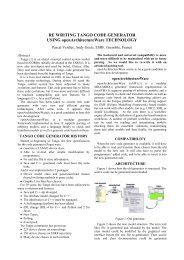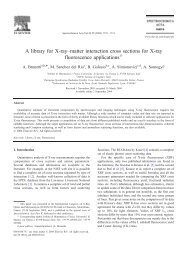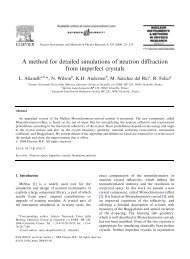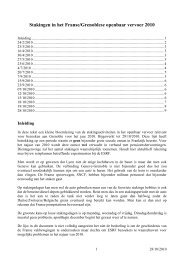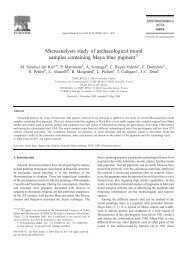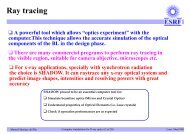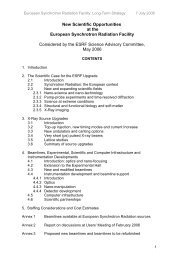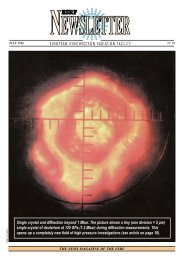Report on future detector requirements at ESRF
Report on future detector requirements at ESRF
Report on future detector requirements at ESRF
You also want an ePaper? Increase the reach of your titles
YUMPU automatically turns print PDFs into web optimized ePapers that Google loves.
EXECUTIVE SUMMARY<br />
Purpose of the study<br />
The <strong>ESRF</strong> is the European centre for synchrotr<strong>on</strong> radi<strong>at</strong>i<strong>on</strong> based X-ray research (<strong>on</strong>e of three<br />
high energy synchrotr<strong>on</strong> sources oper<strong>at</strong>i<strong>on</strong>al worldwide).<br />
In 2009, a ten-year Upgrade Programme was initi<strong>at</strong>ed in order to maintain the success of the<br />
facility and to offer new scientific and technical opportunities to the users. In the frame of this<br />
programme, a large effort is planned to make improvements to the X-ray detecti<strong>on</strong> systems.<br />
The purpose of this study is to compile inform<strong>at</strong>i<strong>on</strong> <strong>on</strong> the present situ<strong>at</strong>i<strong>on</strong> and the expected<br />
needs in terms of X-ray detecti<strong>on</strong> for all the <strong>ESRF</strong> beamlines in the next 10 years. The aim is<br />
not to evalu<strong>at</strong>e the various potential technologies but to describe the beamline needs with<br />
references, when appropri<strong>at</strong>e, to existing technologies or foreseen technical developments.<br />
This report mainly c<strong>on</strong>stitutes a working tool which aims <strong>at</strong> helping <strong>future</strong> decisi<strong>on</strong>s by<br />
summarising all the cases in a single document with a level of inform<strong>at</strong>i<strong>on</strong> as homogeneous as<br />
possible.<br />
Limit<strong>at</strong>i<strong>on</strong>s of the study<br />
This document tries to be as complete as possible but is obviously n<strong>on</strong>-exhaustive. It is a<br />
picture of the <strong>future</strong> detecti<strong>on</strong> needs of beamlines as they can be imagined <strong>at</strong> the moment the<br />
report is written. The inform<strong>at</strong>i<strong>on</strong> is expected to change as the beamline instrument<strong>at</strong>i<strong>on</strong> and<br />
scientific applic<strong>at</strong>i<strong>on</strong>s evolve.<br />
Only phot<strong>on</strong> <strong>detector</strong>s are c<strong>on</strong>cerned by this study and therefore electr<strong>on</strong> or spin detecti<strong>on</strong><br />
have not been c<strong>on</strong>sidered. Incident beam intensity and positi<strong>on</strong> m<strong>on</strong>itors are not taken into<br />
account either.<br />
Finally, other limit<strong>at</strong>i<strong>on</strong>s have to be underlined. This document results from the interacti<strong>on</strong><br />
between the beamlines and the <strong>detector</strong> group and presents the view of the <strong>detector</strong>s by<br />
combining both points of view; it also tries to provide a level of detail th<strong>at</strong> is as homogeneous<br />
as possible for all the applic<strong>at</strong>i<strong>on</strong>s. In practice, it turned out to be impossible to g<strong>at</strong>her<br />
complete inform<strong>at</strong>i<strong>on</strong> for all the cases due a series of circumstances such as the variable level<br />
of m<strong>at</strong>urity of the foreseen techniques or uncertainties in the way some experiments will be<br />
implemented, for instance. C<strong>on</strong>sequently, some parts of the report are much more detailed and<br />
quantit<strong>at</strong>ive than others, which merely provide a qualit<strong>at</strong>ive descripti<strong>on</strong> of certain <strong>detector</strong><br />
characteristics.<br />
First observ<strong>at</strong>i<strong>on</strong>s<br />
Collected needs have been grouped in secti<strong>on</strong>s called “<strong>detector</strong> cases”, as it is explained in the<br />
next secti<strong>on</strong>, “Applied methodology”.<br />
32 <strong>detector</strong> cases have been identified and described: 5 point <strong>detector</strong> cases, 25 positi<strong>on</strong><br />
sensitive <strong>detector</strong> cases and 2 energy dispersive <strong>detector</strong> cases. These descripti<strong>on</strong>s are<br />
expected to evolve with the technical possibilities and the scientific needs. Nevertheless,<br />
several directi<strong>on</strong>s can be outlined.<br />
4



